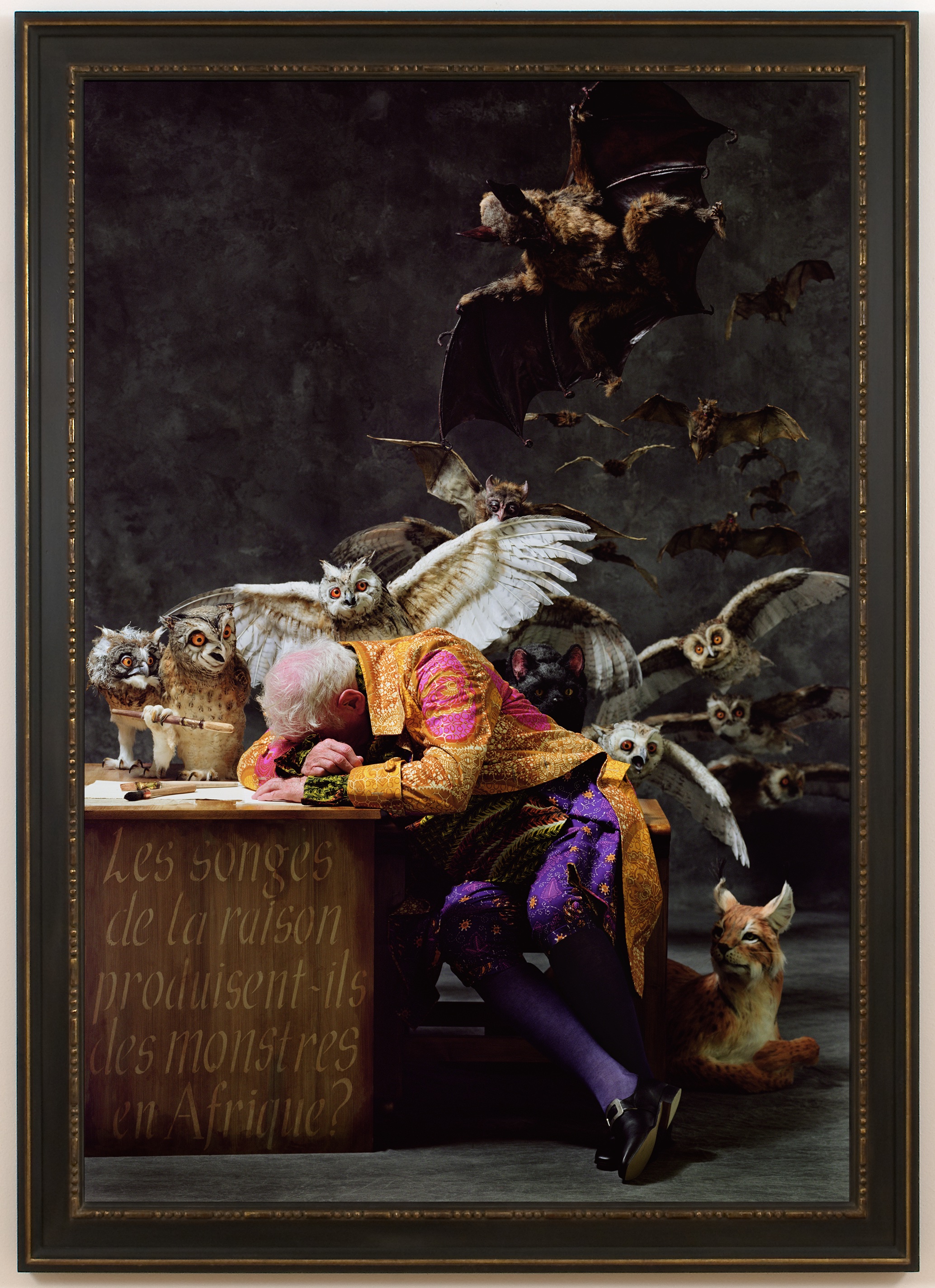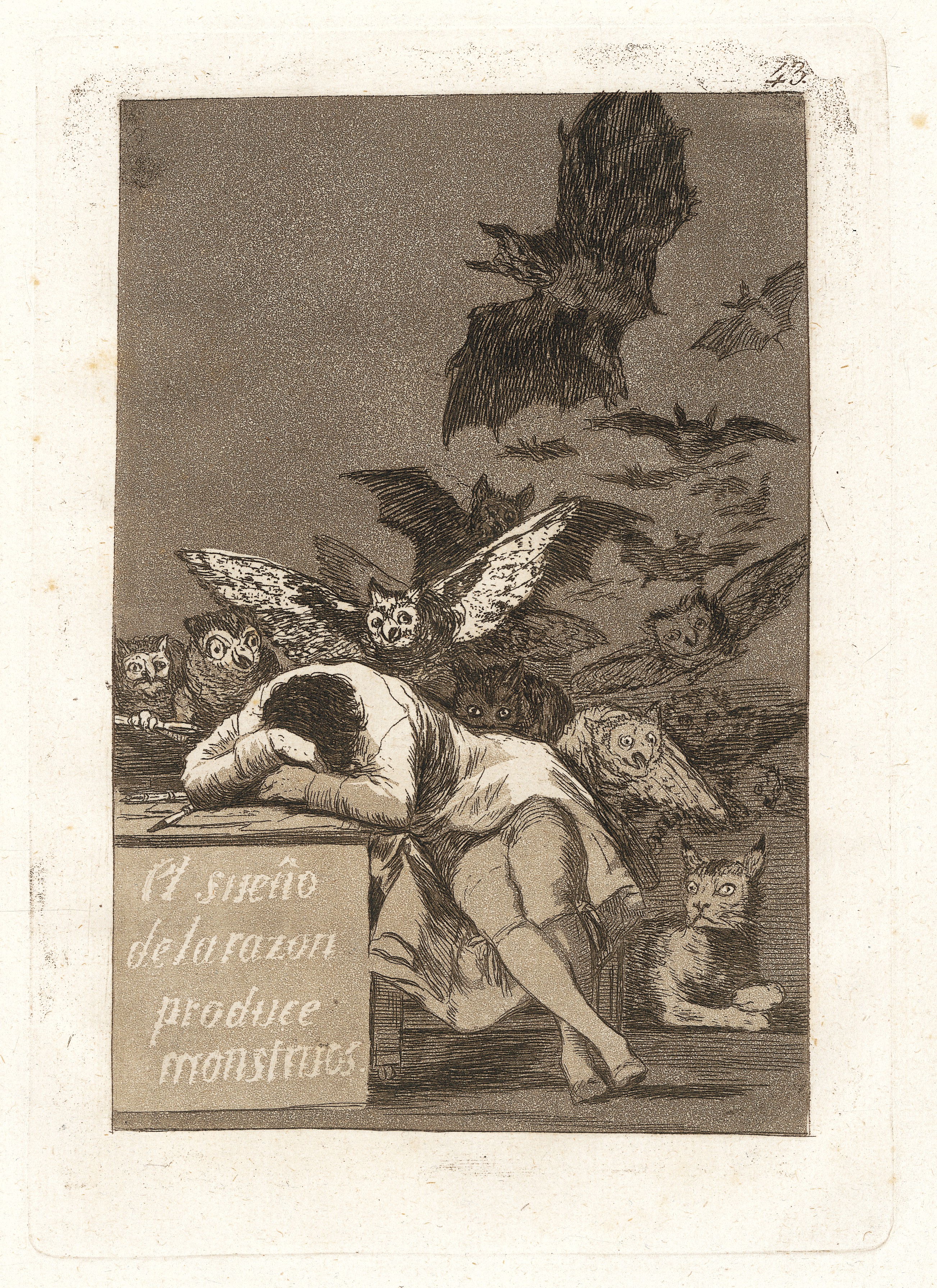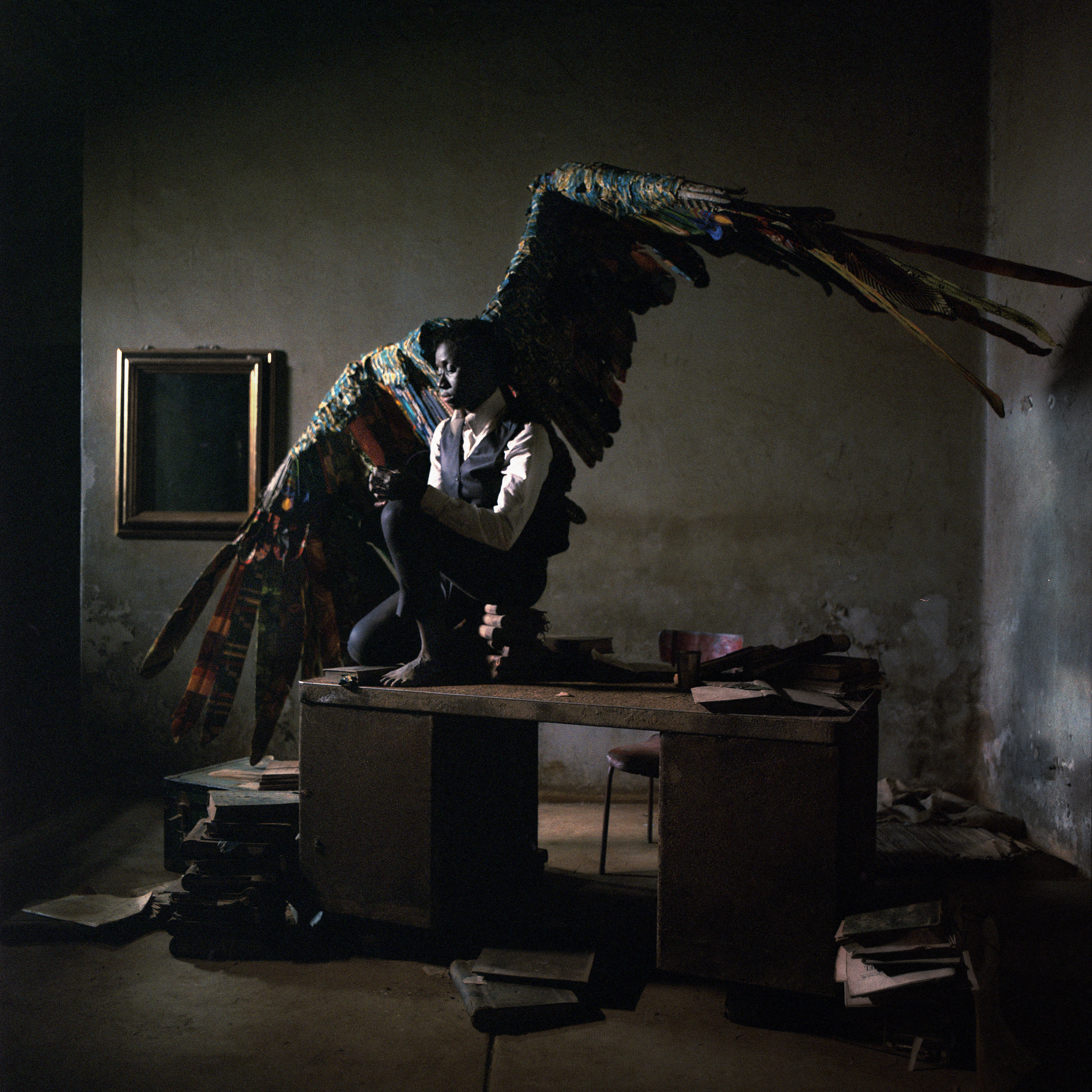Yinka Shonibare, CBE (British, b. 1962)
Working up his nightmare scenarios stroke by stroke, as if from the inside out, he vivifies both the suffering of cruelty and the delirium of inflicting it, without any allowance for a rote response.
–Peter Schjeldahl1
In his series The Sleep of Reason Produces Monsters, Yinka Shonibare recreates El Sueno de la Razon Produce Monstruos, plate 43 of Francisco Goya’s 1799 Los Caprichos, one of the most famous and haunting etchings in the history of art. The moment the human figure begins to dream is the moment the monsters of destruction, embedded in the human imagination, are released. In Shonibare’s series, each of the five iterations represents a different continent and the central figure is a foreigner to it: an African man for The Sleep of Reason Produces Monsters (Asia) and an Asian man for its European counterpart. This serves two purposes: it opens the door for a conversation about why we link culture with race when there is so much migration around the world, or as Shonibare states, the figures “transcend the racialization of personality or culture.”2 But it also emphasizes the exploitation of the African continent specifically, particularly within The Sleep of Reason Produces Monsters (Africa), in which a white man sits slumped over at his desk, asleep. The subjugation of fellow human beings through formal and informal systems is as old as history itself, and stems directly from the human imagination.
The moment Shonibare focuses on is the European colonization of Africa, validated during the 1884-1885 Berlin Conference, at which 12 European nations sat down to divide the continent. Collectively, this process should be viewed as a historically consequential disruption to global ecology, the repercussions of which we are living with today. They are most sharply felt in the Global South, the critical conceptualization of the most economically disadvantaged regions of the world, a disparity that was forged through colonial practice. The consequence of that conference was, as semiotician Walter Mignolo states, “the assumption that there is no modernity without coloniality, that coloniality is constitutive of modernity,” a historical turn that Shonibare has repeatedly mined to characterize European imperialism, in part because the system remains inequitable and therefore continually relevant.3 Throughout his career, Shonibare has regularly broken down the genteel nineteenth-century European elite by constructing their clothes from African textiles; here, that tactic, when coupled with the reference to Goya, makes clear that the monsters of environmental destruction, human rights violations, and corruption are born of the human imagination.
To visually unpack the colonial complex, Shonibare uses Wax Hollandais, wax-printed cotton textiles designed with bold patterns and bright colors, to construct period dressing in an effort to reframe nineteenth-century imperialism as the root of globalization. This mass-produced fabric, which is now ubiquitous across Africa and synonymous with African fashion, was originally manufactured by the Dutch, most famously by Vlisco (originally Van Vlissingen)—still the largest producer and exporter of Wax Hollandais—to sell in the Dutch East Indies. Because it was unprofitable, the Dutch took their production and inventory to Africa, where it took off, due in large part to Ghanaian soldiers in the Royal Netherlands East Indies Army returning home with bolts of the fabric.4 In recreating an industrial-era print but incorporating this anachronistic textile, Shonibare unveils the layers of colonial enterprise, including how its effects remain in place today.
There are numerous readings of El Sueno de la Razon Produce Monstruos, which was produced in a period situated between the Enlightenment and Romanticism. At its very core, the question the etching posits is not, are these creatures figments, simply a perversion of reason during dreams? Rather, the work asks, are they something entirely different? Are they monstrous actions hiding in plain sight, born of the human brain, with the capacity to act within the physical world? Are these nocturnal animals, the owls, lynx, and bats, symbols of “the world’s ‘vulgar prejudices’ and ‘harmful ideas commonly believed?’”5 Literary scholar and critic Paul Ilie suggests that “there are no physical monsters in Capricho 43; it is the concept of monstrosity itself that Goya explores and portrays.”6 Monstrosity is embedded in this composition not because Goya illustrates grotesque beasts, but because he reveals that when we dream, the horrors of our imagination begin to take shape and take flight, outside of control or reason.
Shonibare has continued to explore the consequences of colonization far beyond the obvious exploitation of the African continent. For Shonibare, as for many decolonial thinkers, Imperialism is the intersection of human rights violations, displacement, corruption, and environmental destruction. Hurricanes and viruses are not monsters; it is how humans engage these disasters that makes them into monsters. Manipulating natural occurrences to control and prey on humans is monstrous. In a 2020 interview, Shonibare draws a direct line between imperial domination and the destruction of the earth: “the colonization of Africa is somewhat parallel to the colonization of the planet and the climate change issues we are facing now. Primarily the Industrial Revolution in the West created a situation where Africa was actually being exploited and so the mass industrialization meant that cash crops were encouraged within those African countries and … while the West got richer and continued to pollute the environment on a large scale,” many African countries suffered the irreparable loss of sustainable agricultural and economic potential.7
What emerges from this environmental injustice is a visualization of displacement, for example, the one conjured by Laeïla Adjovi and Loïc Hoquet in the seven-part photographic series Malaïka Dotou Sankofa: a complex creature with a deep history, who has been told they cannot flourish outside the colonial model, but also derided for failing to overcome the centuries of displacement. Malaïka Dotou Sankofa, dressed in a gray Western-style suit, is posed with large wings made of Manjak cloth and Wax Hollandais throughout an old colonial courthouse. The hybrid creature speaks for the forgotten Global South, which has been stripped of their resources for a capitalist agenda, but also told repeatedly to stand on their own two feet. Shonibare’s reimagining of Goya sets the stage for the monsters that follow: the grotesque creatures and injured forms given shape in And I Must Scream were born here, in the dreams of mankind.
Notes
-
Peter Schjeldahl, “Goya and the Art of Survival,” The New Yorker, September 21, 2020, https://www.newyorker.com/magazine/2020/09/21/goya-and-the-art-of-survival. ↩︎
-
“Art for Lunch: Studio Visit with Yinka Shonibare CBE,” interview with James Cohan, January 15, 2021, https://vimeo.com/500985095, accessed February 18, 2021. ↩︎
-
Walter D. Mignolo, “Introduction: coloniality of power and de-colonial thinking,” Cultural Studies 21, no. 2-3 (2007),162. ↩︎
-
In addition to Vlisco, which is still designed and manufactured in Helmond, Netherlands, the Vlisco Group owns three additional brands—Woodin, Uniwax, and GTP—which are produced on the African continent, though they are still designed at the Dutch headquarters. See Vlisco: African Fashion on a Global Stage at the Philadelphia Museum of Art, 2016, https://www.philamuseum.org/exhibitions/845.html, accessed February 18, 2021. See also an article by Sarah Archer, “How Dutch Wax Fabrics Become a Mainstay of African Fashion,” Hyperallergic, November 3, 2016, https://hyperallergic.com/335472/how-dutch-wax-fabrics-became-a-mainstay-of-african-fashion, accessed February 18, 2021. ↩︎
-
Alexander Nehamas, “The Sleep of Reason Produces Monsters,” Representations 74, no. 1 (2001): 37. See also Alfonso E. Perez Sanchez and Eleanor E. Sayre, Goya and the Spirit of the Enlightenment (Boston: 1989), 115, 116. ↩︎
-
Paul Ilie, “Goya’s Teratology and the Critique of Reason,” in Eighteenth-Century Studies, vol. 18, no. 1 (Autumn 1984): 35. ↩︎
-
Yinka Shonibare CBE. Interview for Earth Kids, produced by James Cohan; a film by Greg Poole, 2020. https://www.jamescohan.com/artists/yinka-shonibare-cbe/videos?view=slider, accessed February 1, 2021. ↩︎


